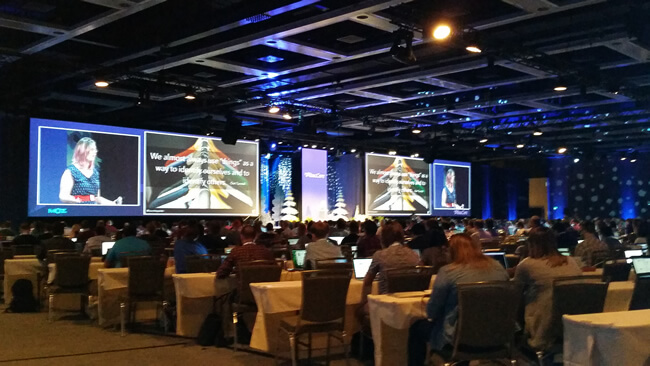DISCLAIMER: This post is written as a live blog from Mozcon. There may be typos and grammar to make my high school English teachers weep. Please excuse those … it’s a fast=paced conference with back-to-back sessions and no time for proofing or even proper writing.

Taking the stage after lunch is Courtney Seiter of Buffer speaking on The Psychology of Social Media.
She begins by discussing the tendency of when you like something people wanting to like something back. This is because social media is changing our brains.
Social Media Biology
What makes it addictive? This is because of dopamine. Use of social media simulates dopamine production because of the lack of finality. A second production is Oxytocin. Tweeting with friends can increase Oxytocin levels by 13% – the same as a groom at his wedding.
A neat state is that Facebook makes up 43% more trustable. Combine this with the the above chemical changes and you’ve got addiction.
Why We Post
In real life we spend 40% of our time talking about ourselves. Online his number jumps to 80% because the etiquette doesn’t exist.
Logos & Brands
A test of people viewing images of logos and brands compares to the reaction of friend though not partner. Interaction with that brand then reinforces our worth but better – it makes you feel part of something larger.
Social Currency
Mashable does a great job. They show a graph as to where content is on a graph allowing the reader o know where they are in the social currency. Are they early on or towards the end in the sharing process?
Strong Messages
Attacks what you take for granted.
44% of us Like once per day. Why?
We perceive it as relationship maintenance. A reinforcement of a relationship which creates a reciprocity.
Selfies
Selfies are a reflection of the power to control the message.
We also really like faces. Humans are wired for it. On Instagram an image with faces in 38% more likely to geta Like.
Faces also create empathy which in turn is a powerful branding tool.
Selfies stations are a a possible branding tool as are selfie campaigns.
They also can humanize your brand. They put a face to the brand and it’s a real face.
EMOJI
Why do we love them? Humans have a tendency to mimic facial expressions. This wasn’t available online until he EMOJI. This has rewired us to mimic the EMOJI. This has also changed our language patter. Acronyms are dropping and EMOJI use is on the rise.
A further note is that it’s power users that tend to use them more.
The best part from a marketing standpoint, according to Courtney, is that people don’t even see it as advertising – they see it as self-expression.
Allows us to idealize a moment effectively accelerating nostalgia.
Discovering that retro-90s is a thing let’s us know that we don’t have to do back too far for nostalgia. We only have to tap into a time that makes our audience warm and fuzzy.
Social Comparison
We use social to compare with our friends. But we’re comparing with the best of how they present themselves.
We get the impression that everyone’s life is better than ours even when it’s not.